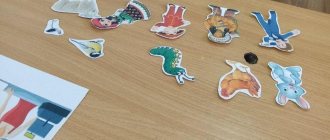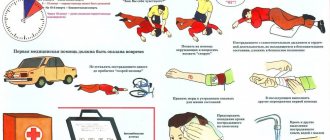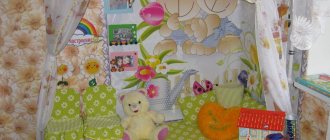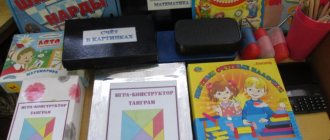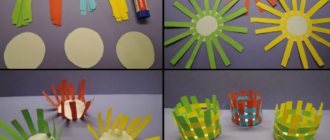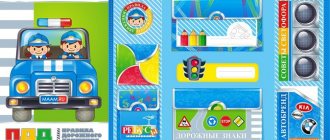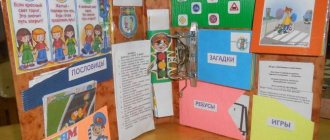Do-it-yourself non-standard physical education equipment in kindergarten
Content
It is very important for every parent that in kindergarten the child not only spends time when adults are busy, but also develops. To do this, we will make non-standard equipment for physical education and our children will achieve high results.
It is before school age that all vital processes in the body are formed in a child. Therefore, physical education classes and children's educational games are of great importance in kindergarten. In this article you will find useful tips on how to create original objects for children's development. The most important thing is that they are created with your own hands from available materials that can be found in every home and are completely safe. And most importantly, if you are a resourceful and active parent, you can even make such masterpieces for the development of your baby at home or in the country.
1. Walkway for the prevention of flat feet. It is made very simply from everything you can find. For example, from egg trays (for better perception, each tray is painted a separate color), or plastic lids. You can also use other materials for such tracks: strands, beads, buttons, etc.
2. To prevent coordination. You can build a balance beam from wood.
3. To develop fine motor skills. Various winding sticks are made. These are ordinary wooden sticks, where one end of a rope or ribbon is tied, and on the opposite side some trinket.
4. To develop dexterity. You can build two towers from durable material and mugs from plastic boxes from kinders. Or make balls from socks filled with sand and plastic targets. The main task of the baby is to hit the target, you can complicate the tasks according to the color purpose. You can use plastic bottles (to make pins out of them) and the same bags of sand for throwing at the pins.
5. To develop breathing, bottles with a straw inside are made. The bottle contains foam. When the child blows into the tube, the foam will rise. Or a table football field for blowing paper balls into the opponent’s goal.
6. To develop dexterity and synchronize movements, use the game “Catch the Ball.” They are made from a plastic bottle and a ball (kinder base) on a string.
7. To prevent visual impairment - a visual track.
8. For physical exercise: dumbbells made from plastic bottles, jump ropes made from yogurt bottles and shoelaces, and a metal bow.
Non-standard physical education equipment, with the right approach, will help a child develop and grow even in kindergarten. Make it yourself and contribute to the future of your children.
Video:
You are not authorized to post comments.
be-missis.ru
USE OF PHYSICAL EDUCATION EQUIPMENT IN KINDERGARTEN
To carry out the tasks of physical education in preschool institutions, physical education equipment is used: stationary and portable; physical education equipment for sports institutions and games, physical education aids.
Requirements for physical education equipment:
- all equipment and inventory used on the site and indoors must comply with the rules for protecting the life and health of children, hygiene and aesthetics requirements;
— the dimensions and designs of equipment and aids must correspond to the anatomical and physiological characteristics of children and their age.
The sports ground and gym in every kindergarten must be equipped with everything necessary. The physical training ground must have: a pit with sand for long jumps (dimensions 4x4, depth - 40 cm); arches for climbing (height - 40-60 cm); Swedish wall (height -2.5-3 m); balance beam (length -5 m, height - 40 cm); racks for stretching the net (for playing ball, badminton; different types of pyramids for climbing; running track (length - 30 m); targets of various types; football field (length - 20 m, width -15 m).
The equipment of the gym consists of: a gymnastic wall (height - 2.5 m); gymnastics board (length - 2.5 m, width - 20 cm); gymnastic bench (length - 3 m, height - 20, 25, 30 cm); targets of different types; racks and bars for jumping; aids for performing physical exercises (balls, sandbags, hoops, ribbons, gymnastic sticks, cubes, rattles, cords, etc.); simulators.
To ensure the effectiveness of the use of physical education equipment, first of all, it is necessary to select and combine different types of it into sets, taking into account the specifics of placement in different rooms and outdoors: in a separate gym of a kindergarten, a music and physical education hall, a group room without bedrooms and with bedrooms, a dressing room room, physical education area, group area, etc.
158
It is advisable to include in the kit: stationary equipment (1-5 units), a set of physical education aids, consisting of balls, hoops, jump ropes of different sizes; portable (stepladder, slide, rocking bridge); prefabricated structures that make it possible to transform the parts of the kit; physical education aids that can be hung, attached, combined with a stationary one; parts for combining with stationary and portable equipment (special hooks, latches, tapes); additional physical education aids in the form of visual landmarks (planar paths, geometric shapes, etc.); game details-attributes (steering wheels, badges).
It is very important to provide convenient placement of equipment so that children have the opportunity to approach it from different directions without interfering with each other.
The positiveness and frequency of use of equipment increases if each of its types is used for a wide variety of movements. So, for example, on a gymnastic bench and board you can walk, run, crawl in different ways, perform all kinds of actions with balls, etc.
One of the techniques for increasing the effectiveness of physical education equipment is to create novelty. Children get tired of monotony, they stop noticing their most favorite toys. Novelty is created by changing portable equipment, placing additional (mounted, attached) equipment on stationary and portable equipment; combining different aids into unique complexes (obstacle courses, paths, fences, houses); permutations of benefits in different spatial arrangements.
Interesting techniques of novelty, in which physical education equipment turns into play equipment. So, for example, in the summer on the site it is enough to use ordinary awnings. To make them, you can use any fabric (tent, cotton flannel), preferably in bright colors. To quickly and conveniently secure the awning, you can sew buttons, ties, and ribbon to it. The awning can be decorated with a plot applique and windows can be cut out.
Options for using physical education equipment (see table).
159
Physical education equipment is temporarily (for one day or one walk) turned into play equipment. Once you attach a strip of fabric to the vine, a house, hut, tent, theater area and much more are ready.
Different scenes can be played out on vertical and inclined stairs. An ordinary ladder can be turned into a rocket or a spaceship. A special tent-target is fixed between two ladders, trees, on a horizontal bar, put on a bench, or a block of wood. If you fasten the awning on top or on the sides of the collars, then it will be a tunnel, or maybe a house, a garage, a zoo. You can play steam locomotive and bus here.
The rational use of physical education equipment has its own specifics depending on the age of the children.
In younger groups, it should contain a play element, giving the child the opportunity to freely move from “purely motor” activity to play and vice versa, creating conditions for his fullest self-expression in activity. You can ensure a variety of motor activities using a very small number of simple aids: firstly, arranging them differently; secondly, teaching children all the basic movements on each of the benefits; thirdly, developing in children the ability to perform all familiar movements in each manual; fourthly, uniting children in joint movements with one aid (jump rope, ball, hoop for two).
When adding aids to the group, you should arrange them slightly differently each time: in another part of the room, in a different spatial arrangement (for example, a portable ladder can be placed on the floor, with its ends on two chairs, inclined, sideways), supplement the main aids with small details ( put a cube on the board for stepping over, a ball on the gymnastics bench that will “tell” the children a new movement); gradually combine different aids into sets (for example, a board, several cubes, an arc are arranged in a row in the center of the group room, etc.).
Physical education equipment is added to the group depending on the time of day, the nature of the children’s previous and upcoming activities.
So, during the morning reception, benefits are calculated for moderate, “average” mobility of children. Uchity-
161
There is one more circumstance: the teacher is busy receiving children, he cannot pay due attention to guiding motor activity, therefore preference is given to aids for simple movements that are well known to children and do not require insurance: this is a cord, a jump rope, a rope; regular board, ribbed, inclined; cubes, pins, arcs, etc.
After breakfast and during a walk, children should actively rest before “sedentary” classes (in this case, they will better learn the lesson material), and largely satisfy the need for movement. The teacher has the opportunity to pay attention to each of the children a little more than in the morning. Therefore, benefits at this time are more complex, requiring special supervision or guidance from the teacher.
In the afternoon, children’s motor activity is organized immediately after sleep, as well as after an afternoon snack, during a walk. Here she can be active, highly emotional, and creative. It is advisable to give preschoolers simple objects with which they can move a lot and in different ways (balls, hoops, different in size, made of different materials).
Preference should be given to prefabricated structures, so that you can, at your discretion, turn the physical education complex into a “fire escape,” “observation tower,” or “ship mast.”
By effectively using physical education equipment, the teacher will provide varied and interesting activities for children.
APPLICATION
Non-traditional physical education equipment (do-it-yourself)
"Magic rug"
This equipment is made of plastic bottles with caps based on drape fabric.
Designed for barefoot walking, correction and prevention of flat feet, hardening. It is used for physical exercises, during wake-up exercises, and joint sports events with parents.
"Footprints and palms"
This equipment is made from pieces of linoleum.
Used for outdoor activities and entertainment, to reinforce the concepts: “right leg”, “left leg”, “right hand”, “left hand”. Promotes the development of coordination of movement, memory, dexterity, strengthening the muscles of the legs and arms, attention.
"Breeze in a Bottle"
This manual is made from a plastic bottle, colored paper, and cocktail straws.
Used for breathing exercises. Develops respiratory organs.
"Sultans"
Made from sticks and colored ribbons and ribbons.
Designed for performing general developmental exercises, breathing exercises, organizing outdoor games, and competition games. Promotes the development of respiratory organs and trunk muscles.
"Bilboke"
Made from plastic bottles, fishing line, Kinder Surprise capsules, for decoration: colored adhesive paper.
Designed to hit the target. Develops eye, attention, reaction speed, manual dexterity.
"Sports cubes"
Made of plastic cubes, paper with silhouettes of a person performing various exercises.
Intended for use in independent play activities, organized educational activities, and for working at home with parents. Helps strengthen body muscles, develop general developmental exercises, attention, coordination of movements, and speed of reaction.
"Nimble Mouse"
Made from a ball, a mat glued to a wooden base, a spring, and a mouse toy.
Designed to hit the target for playing individually, in pairs, or as a team. Develops eye, attention, reaction speed, manual dexterity.
Expander
Made from five-liter plastic cans and elastic.
Designed to develop strength.
Dumbbells
Made from plastic bottles, colored tape and sand (or other material for filling them).
Designed to develop strength.
Multi-colored balls
Made from small plastic bottles, filled with colored rain, candy wrappers, etc.
Designed to perform general developmental exercises, basic types of movements, massage and self-massage, prevention of flat feet, development of fine motor skills, used as substitute objects for role-playing games.
Tunnel
Made from aluminum hoop and thick fabric.
Designed for climbing. Used in outdoor games, when performing basic types of movement, in role-playing games.
Walkers
Made from painted wooden blocks and clothesline.
Designed to perform basic types of movement, to develop movement coordination, and for independent play activities.
Sports bags
Made of thick fabric and filled with beans, you can use other filler (small pebbles, beads, peas, etc.)
Designed to perform general developmental exercises, basic types of movements, massage and self-massage, and prevention of flat feet.
dohcolonoc.ru
Blog of Elena Ishimova: Non-traditional physical education equipment
Another Health Month event in our kindergarten is a competition of non-standard physical education equipment.
It was enough to imagine one thing, but having discovered a lot of interesting ideas on the Internet, I wanted many! Therefore, without inventing anything, we repeated an already existing experience. Having tried our simulators on children, I agree that the colorful multifunctional aids delight children! They enrich motor experience, allow you to diversify movements in a new, more interesting form, develop a sense of shape and color, imagination and creativity. Thanks to them, the children's interest in physical education has increased, and all the children join us during exercise! We present to you non-traditional physical education equipment, made from improvised (or simple) materials with your own hands and with the help of parents. Theater "Friends of Moidodyr"
, which will help strengthen children's hygiene skills: Soap, Sponge, Towel, Handkerchief and Microbe. An entertainment script for children with the participation of parents has already been prepared. Unfortunately, I didn't save the link.
“Get into the Cup”
is a guide for developing hand motor skills and eye control, and consolidating knowledge of primary colors. Made from cardboard laminated with tape, plastic bottles and colored self-adhesive tape. Knitted balls are tactile (soft and crunchy). link
“Traps”
- for developing dexterity, attention, reaction speed and eye. link
“Blow a butterfly off a flower”
guide helps to increase breathing volume and develops the ability to perform a smooth, long exhalation. Material: discs, self-adhesive tape, electrical tape, colored paper. link
Manual
"Colorful Snakes"
.
Goal: prevention of flat feet in children, development of fine motor skills, development of mathematical skills. Material: lids, rope. link Tactile bags
made of fabrics of different textures, filled with nuts, pumpkin seeds, pasta and cereals.
"Soft billiards"
and
“The Magic Blanket”
next time. And now I propose to look at the non-traditional physical education aids presented at the competition by other groups.
Soft floor checkers, sand throwing bags, massage button mats, "Golf of the Future", "Twister 0+" with left and right prints, Elephant ring thrower for rolling the ball, Snake, knitted Giraffe ring thrower with a basket for throwing balls, tactile mat for practicing forward bends.
Soft hopscotch, “traps” and “winders” for the development of hand motor skills, braids for doing exercises, “skis” (for two people at a time), stilts, a throwing cell for the smallest ones, a simulator for developing posture, massage gloves,
A trainer for long jumps, and a mat for stretching the muscles of the back and legs (sit on the shore-cushion, spread your legs to the sides and reach for the fish attached to the contact tape)…
A lot of work has been done by teachers and parents of children.
We shared first place with the teachers of the groups “Little Red Riding Hood” and “Cockerel”! HOORAY!!
ks337.blogspot.com
We make non-traditional physical education equipment with our own hands!
The health of children should always come first. And everyone knows that nothing strengthens it more than physical education. Therefore, love for it must be instilled from a very young age. In order to somehow get children to move more and, most importantly, usefully, they need to be interested. Non-traditional physical education equipment will just help them look at sports from a different perspective and turn exercise into a fun game. This will significantly diversify a child’s life. In addition, you can make non-traditional physical education equipment with your own hands.
What it is
Various exercises are very important for children to help develop fine motor skills. This, above all, has a positive effect on their psyche and reduces the incidence of illness. Non-traditional do-it-yourself physical education equipment, a photo of which you can see in our article, puts the emphasis on such exercises.
The big plus is that with the help of such equipment you can play games of various types:
- training;
- entertaining;
- adversarial.
In principle, if you use your imagination, you can even prepare a special performance with interactive inserts (for example, how to defeat Koshchei using physical education classes).
How to make non-traditional physical education equipment with your own hands in kindergarten and at home
This equipment is very easy to make. Do-it-yourself non-traditional physical education equipment is made from available materials: bottles, caps, ropes, Kinder surprise packaging and other things that can be found in every home.
It doesn't take much time to make. You can also involve children to help. They will be very interested. When creating products, you should try to use your imagination and come up with something of your own. There are no restrictions here. But, of course, you can take advantage of already known developments in this area.
Bilbock
Everyone knows the game where a ball tied to a stick needs to be thrown into a special bowl. This is bilboke. Making such non-traditional physical education equipment with your own hands from available materials is as easy as shelling pears. For this you will need:
- plastic bottle with cap;
- wool thread;
- packaging from Kinder Surprise;
- decorations.
First you need to cut off the bottom of the plastic container. It is advisable to do this so that there are no pointed ends left. Using an awl, a hole is made in the yellow Kinder egg through which the thread is threaded. To prevent it from jumping out, a knot is tied at its end. The second end of the rope is threaded through the neck and screwed together with the lid. In order to make the bilboke more colorful and attractive, it should be covered with bright tape. You can use printed pictures, glitter and beads.
Games with bilboke help develop reaction and coordination of movements.
Pouch
It would seem, how to use it? But it can be found in many applications. For example, bags can be placed on the head so that children maintain their posture at all times. Since problems with spinal curvature are becoming more common, such exercises will be very useful. You can sew a bag from ordinary thick fabric. The filler will be salt or sand.
Magic bottle
A very simple product. To create it you will need a transparent plastic bottle, a cocktail straw, confetti or foil.
You need to make a hole in the lid. A tube will be inserted there. Small confetti, cut foil or large glitter are placed in the bottle itself.
The child should inhale through the nose and exhale through the mouth into a tube. This way he masters the correct breathing technique and watches the cheerful “fireworks” inside the bottle.
Air football
A very interesting and simple game. You don’t need a lot of materials to create such non-traditional physical education equipment with your own hands. All you need is a large box lid (or just cardboard), a plastic cup, colored paper, glue, straws and a small ball.
It is also easy to do. The lid of the box (if it doesn’t exist, you can simply make the sides out of cardboard) is covered with green paper on the inside. This will create something like a field. The gate can be made from halves of a plastic cup. They score goals on such a field using straws. You need to use a stream of air to drive the ball into the makeshift gate.
Tunnel
With it you can create a whole obstacle course. To create a tunnel you need a large piece of fabric and thick wire. First, the fabric is stitched. Then a few more small strips are attached on top across the tunnel. They will hide the wire so children don't get hurt.
Beast racing
Using regular tape, a beautiful stick and a soft toy, you can make an exciting game that will help develop fine motor skills in your child’s hands. A soft toy is tied at one end, and the other end is tied to a handle. It is important that the ribbons are all the same size. The task is simple: you need to twist the handle, winding the rope around it. This way the toy animal will slowly move towards the baby. You can organize whole competitions.
Robin Hood
With the help of non-traditional physical education equipment, you can organize an entire throwing tournament with your own hands. You don't need a bow and arrow to become a real Robin Hood. Just a tray of eggs, paints and Kinder packaging is enough. We decorate the tray so that it looks like the target. That is, in the center there should be a small square painted red. This will be an apple. Next is a slightly larger yellow circle, and then a green one. Instead of throwing arrows, you will need to throw Kinder packaging. This interesting game helps develop coordination, accuracy and dexterity.
fb.ru
Premises and equipment for physical exercises
Topic 2.2.4. Premises and equipment for physical exercises
The effectiveness of implementing the tasks of educating preschool children in the field of physical education largely depends on the presence of a rational subject-play environment in a preschool institution. The most important factor in the influence of the environment on the formation of a child’s personality is the premises in which his activities are organized.
Room
for physical exercise, it should be spacious enough so that the “air cube” indicators approach the volume of ventilation. If the room is small, then the number of children studying at the same time should be limited in accordance with these indicators.
However, in preschool institutions these requirements are not always met. This is because many institutions do not have standard gyms. To conduct physical exercises, I equip small group rooms or utility rooms. They can conduct classes only in small subgroups, which is not always feasible due to the need to coordinate the work of a physical education specialist with the work of other employees of the institution.
It is known that the effectiveness of a child’s activities and the improvement of his well-being are influenced by rational coloring
room walls. When choosing a color, psychologists recommend using a range of colors in rooms for children from yellowish-green through yellow to orange. At the same time, blue and green colors are also suitable for children's rooms, especially those oriented to the south, as these colors create a feeling of coolness.
It should be especially noted that the equipment
, used in the physical education of preschool children, is usually painted in bright, varied colors. Thus, in order for children to clearly see the objects they are working with, it is advisable for the walls and floor in the gym to be plain and not bright.
Sometimes the floor in the gym is covered with carpet with a large, colorful pattern. On such a covering, markings and equipment are difficult to see, which does not meet the requirements for protecting the child’s vision. The use of synthetic turf in the gym limits the choice of means of physical improvement for preschool children. For example, when performing exercises in the kneeling position, redness of the skin of children is observed from contact with a synthetic carpet. In addition, such a coating requires particularly thorough cleaning.
View of the gym
should create a mood in the child for the upcoming activity. In this regard, painting the walls with fairy-tale characters makes the hall look like many rooms of a preschool institution (locker rooms, corridors, etc.). the use of removable pictures with monochromatic walls makes it possible to easily change the theme of the lesson. Often in preschool institutions you can see curtains on the windows of the gym, which does not meet hygienic standards (dust, reduced light).
In sports halls it is necessary to provide window guards. For this purpose, various gratings and meshes are used. For lighting the gym, fluorescent lamps protected by removable grids are most appropriate.
Due to the fact that at present there is no centralized provision of sports, gaming and physical education equipment and equipment,
preschool institutions have to take on this task themselves.
When selecting physical education equipment, it is mandatory that it meets pedagogical and hygienic requirements.
In a preschool institution it is necessary to have a sufficient number
a variety of sports and gaming equipment to ensure the participation of all groups (subgroups), their physical activity in the process of organized physical education classes and outdoor games, as well as in the independent activities of children in their free time.
It is important that the dimensions of the equipment
corresponded to the anthropometric indicators of children: body length in a standing and sitting position, length of arms, legs, volume of the chest, head. Only in this case can comfort of motor actions in a sports and gaming environment be achieved. The dimensions and weight of portable equipment must be commensurate with the capabilities of the children and can be moved by the children themselves.
One of the necessary requirements is security
children when using the equipment. Each benefit must be durable, reliable, suitable for use:
- Stair slats - of sufficient thickness and strength;
- Connections of various parts are reliable, without sharp corners or sharply protruding parts;
- Tools made of wood are well protected and polished.
The reliability and stability of large aids (gymnastic ladders, stands, monkey bars, crossbars and other pieces of equipment on which children climb) must be ensured. In order to provide insurance and prevent injuries in gyms, it is necessary to have a set of large and small mats
.
Physical education and sports and play equipment for preschoolers is made from different materials. It is important that these materials have a hygienic certificate
, would not have harmful effects on the body of children. It should be noted that for preschoolers, gymnastics and play equipment made of wood is preferable.
The presence of a wide variety of types of equipment in the kits is due to the specifics of the construction and content of classes and other forms of work in physical education, which consists in the fact that each form includes different types of physical exercises and games. For the correct organization of the physical education process, it is important to observe the principle of placing equipment at the place of use, taking into account its originality, which corresponds to the characteristics of motor actions characteristic of certain conditions. Thus, physical education and sports and gaming equipment for indoors
(physical education and gyms, swimming pool, group rooms) and
equipment for the site
(physical education area, group areas and other play areas).
Particularly highlighted is the equipment for organizing sports games
(basketball, badminton, gorodki, football, hockey) and exercises such as skating, cycling, skiing.
Equipment and supplies for the gym
As a rule, most of the physical education and sports equipment is used in gyms. The efficiency of equipment use increases significantly with its rational placement. The placement of different pieces of equipment depends on their dimensions
and
purpose
.
So, the gymnastic wall is installed permanently, firmly attached to the wall. Ropes, poles, rope ladders are fixed to the ceiling using special devices - hooks, monorail, etc. Large pieces of equipment,
such as gymnastic benches, booms, cubes, are placed along the walls of the room. For boards and ladders with hooks, a place is provided where they can be hung or laid so that they do not interfere with children’s games and activities.
Small physical education equipment
- balls, bags with weights, cubes, clubs - it is advisable to place them in sectional cabinets, on special shelves, racks, in drawers, also located along the walls of the gym. It is best to place hoops, cords, and jump ropes on the walls in different places in the room on special hooks and hangers. For stretching nets (for playing with a ball), pulling cords, elastic bands (for hanging small objects, for crawling, jumping over), fastenings in the form of brackets, clips, carabiners are convenient. They should be placed in pairs at different levels of opposite walls.
Equipment must be located so that children can freely
approach it,
independently
, without interfering with each other. It is advisable to leave the middle of the hall free. It contains a variety of aids for games and activities organized by the teacher or the children themselves.
Modern production technologies and materials have made it possible to change the appearance of the gym. Large companies, Vesco, etc.) constantly offer preschool institutions equipment that has successfully proven itself in Europe and America. Today in the halls you can find trampolines, dry pools, parachutes, etc. Large-sized multifunctional environment-forming objects
– modules that promote the gradual development of generalized conditional actions, an imaginary situation, and also naturally enrich the child’s range of movements.
In the early 80s. XX century In Switzerland, and then in Italy, Germany and other countries of Western Europe, large bright multi-colored balls with a multi-purpose orientation of impact appeared. The new tool is called “fitball”.
The development of new health technologies has given impetus to the use of special gymnastic balls in the practice of physical education, health and sports work with preschoolers. The ball can be used both as a training device and as an object for weights. In preschool institutions, fitballs are used primarily to solve health problems. They make it possible to individualize the treatment and educational process as much as possible due to the wide possibilities for posture correction in both the frontal and sagittal planes.
simulators have begun to be actively used in preschool institutions.
as a means of increasing children's physical activity. When used systematically in a preschool institution, they are a reliable means of preventing physical inactivity in children. It should be noted that exercise equipment designed for adults cannot always be adapted for use with children.
Saturating the gym with new equipment does not reduce the importance of physical education equipment, which has proven itself over many decades of practice in organizing physical education and health work with preschoolers. A modern gym cannot do without gymnastic walls, benches, mats, rubber balls of different diameters, hoops, jump ropes, etc.
Equipment and supplies for outdoor activities
For the full physical development of children in a preschool institution, the playground must be well equipped. This is especially important for optimizing the physical activity of children in the summer.
Physical education area
should consist of a physical training ground itself and a number of sports and play areas:
- Jumping pits;
- Treadmill;
- Tracks with obstacles;
- Playgrounds for playing small towns, mini-football, and hockey.
Sports and gaming areas can be directly adjacent to the physical education site or be located at any other convenient location on the site. This functional division of physical education areas allows you to simultaneously organize games and activities with a large number of children of different ages and physical fitness. In the winter season, they are equipped with sliding tracks, an ice rink, slides, and a place for playing hockey. A ski track is laid along the perimeter of the kindergarten site.
The main space of the physical training ground, as a rule, remains free. All the necessary equipment - 5-6 spans of a gymnastic wall, beams of different types (inclined, horizontal at different levels), monkey bars, throwing targets, a device for hanging ropes, a pole, a rope ladder - is placed around its perimeter. In the middle of the longitudinal sides of the site, it is advisable to install racks for tensioning nets, cords, etc.
Small inventory
for sports games (nets, rackets, shuttlecocks, balls, towns, etc.), aids for outdoor games and exercises (jump ropes, hoops, cords, rings, balls, etc.) are brought to the site as needed.
If there is enough free space around the physical training ground, it is advisable to equip a treadmill
, the width of which must be at least 1.5 m. It is important that it has a straight segment of at least 40 m in length. This will allow not only running exercises, but also observation of their implementation at a 30-meter distance in a familiar environment for children .
an obstacle course near the physical training ground.
for older preschoolers. This arrangement of the obstacle course will make it possible to widely use the equipment located on it in the independent motor activity of older preschoolers.
On playgrounds for children, it is desirable to have natural earthen slides, which in the summer can be used for entering, running down, and in the winter - for sliding down on a sled.
Pool equipment and supplies
To organize classes to teach children to swim, the pool must have equipment to ensure safe swimming and insure children in the water. These are lifebuoys, floats, dividing paths, a long pole, etc.
A variety of aids and toys are needed for the most effective organization of swimming lessons, for various exercises and games on the water. These include:
- Foam boards;
- Inflatable toys (rubber circles, balls, toys in the form of fish, crocodiles, turtles, etc.);
- Small toys made of dense rubber (sinking, for finding under water);
- Hoops for playing games with immersion in water.
The number of such aids and toys must correspond to the number of children simultaneously exercising in the pool. They should be colorful, bright, and attract children to activities and games in the water.
In addition, the pool must have devices that allow you to monitor and maintain the appropriate sanitary and hygienic condition of the room and water.
Physical education and gaming equipment for group rooms
A minimum set of physical education and gaming equipment must be provided in group rooms. This is especially important for children of early and early preschool age.
In groups for young children
, in addition to playpens for the little ones, in accordance with their age capabilities, a slide with a ramp and a ladder, a stepladder, and two or three spans of a gymnastic wall are installed. Here it is advisable to have boards smooth and with a ribbed surface, a set of boxes, baskets, massage paths and with markings, as well as sets of balls, marbles, rings, rattles, and attributes for games. Soft objects are good for kids - various modules, rollers, segments, cubes, disks, all kinds of motor toys are especially important - wheelchairs, strollers, cars, carts, etc.
In groups of older children
in addition to small aids (balls, jump ropes, cords, sticks, hoops, etc.), you must have sets of equipment and inventory for organizing both outdoor and sports games (skittles, ring throws, gorodki, badminton, basketball, table tennis, etc. ). Children can take these benefits to the area for games and exercises during walks. If there is space in group and locker rooms for children, you can install one or two spans of gymnastics walls, one of the sports and gaming complexes, and place the simplest exercise equipment for children to use independently. But at the same time, we should not forget that older preschoolers should also be monitored by the teacher during games and exercises on the specified equipment.
Devices necessary for diagnosing the physical condition of preschool children
For an objective assessment of physical development and physical fitness in medical, methodological rooms or in a gym there must be:
- Height meter;
- Posture assessment device;
- Phonendoscope;
- Device for measuring blood pressure (tonometer);
- Spirometer;
- Stopwatch;
- Roulette;
- Tape measure;
- Tailor's measuring tape;
- Wrist dynamometer;
- Pedometer to determine the number of movements;
- Compass.
In recent years, the possibilities for assessing the activity of various body systems have expanded significantly. One of the most promising areas is the use of heart rate monitors
to assess the reaction of children’s bodies to various physical activities and performing physical exercises of varying degrees of difficulty.
The device enables reliable and convenient wireless heart rate measurement and measures pulse with the accuracy of an electrocardiogram. The monitor allows you to observe the current heart rate level without disturbing the overall rhythm of the exercise being performed. Observation can be done while walking, swimming, skiing, or while performing other exercises.
Heart rate monitors are used in research because they are easy to use. The device consists of an elastic belt containing electrodes that measure heart rate, and a monitor (shaped like a watch). The elastic belt is attached to the pectoral muscles, and the monitor is attached to the wrist.
It should also be noted that heart rate monitors have a wide price range. The cheaper the device, the correspondingly fewer functions it performs. When conducting research with preschool children, the following should be considered first:
- The device must provide for transferring data from the monitor to the computer using an infrared port. Other options for reading information have significant errors when transferring data;
- More expensive heart rate monitor models include transmitter coding. Uncoded transmitters should not be used in group studies of preschool children. In cases where there are multiple heart rate monitors within a study area within a distance of 1 meter, an unencoded monitor will read signals from other monitors in that area. This may cause incorrect readings. Even if one monitor is coded and the other is not, the readings may also have significant errors.
In a study with preschool children, it is advisable to use the Polar RS200sd running computer model with an additional POLAR S1 device, which is attached to shoes and provides control over speed and distance along with heart rate measurement. The device provides the following functions:
- Displaying speed and distance on the monitor;
- Setting a target pace;
- Showing the difference between the current pace and the specified target;
- Signal of deviation from a given pace, etc.
Studying the reaction of children's bodies to physical activity using heart rate monitors makes it possible to obtain objective information. However, this creates certain difficulties in organizing the educational process in physical education in a preschool institution. Therefore, during a physical education lesson, it is advisable to assess the functional state of children based on external signs of fatigue or pulse. At the same time, complex diagnostic systems, in particular heart rate monitors, can be used 2-3 times a year to obtain more objective indicators.
In preschool institutions you can increasingly find the biofeedback device “BFB - Breathing”.
They make it possible to visualize the processes occurring in the body.
“BFB - Breathing” allows you to determine the difference in pulse values during inhalation and exhalation, which is currently called respiratory arrhythmia of the heart (RAS). Quantitatively, this parameter is measured in the same quantities as the pulse, i.e. in the number of beats per minute. This parameter is universal - it reflects the quality of breathing, the state of the immune system and the body’s ability to adapt. The higher the DAS level, the better the body is protected from diseases.
It should also be noted that DAS reflects the degree of coordination of the respiratory and cardiovascular systems. With good diaphragmatic breathing, an increase in DAS is observed, and it begins to change in the phase of the respiratory cycle. Moreover, by consciously changing breathing parameters, you can influence heart rate, and ultimately DAS. The use of the device provides the opportunity to individualize health programs, i.e. selection of exercises necessary to achieve a programmable healing effect.
